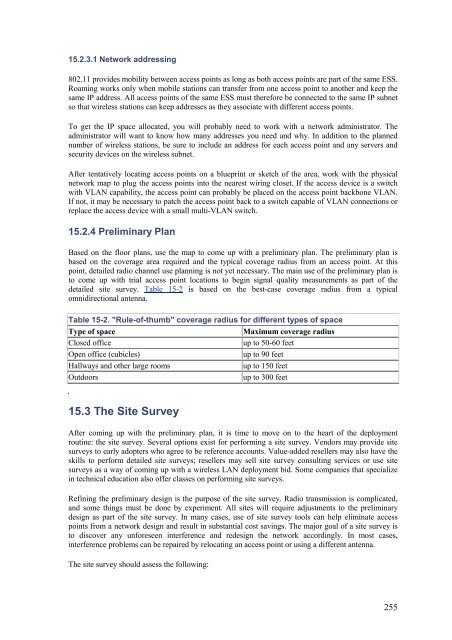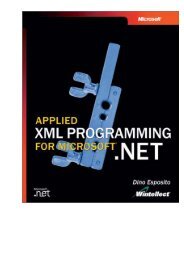Wireles Networks The Definitive Guide.pdf - Csbdu.in
Wireles Networks The Definitive Guide.pdf - Csbdu.in
Wireles Networks The Definitive Guide.pdf - Csbdu.in
Create successful ePaper yourself
Turn your PDF publications into a flip-book with our unique Google optimized e-Paper software.
15.2.3.1 Network address<strong>in</strong>g<br />
802.11 provides mobility between access po<strong>in</strong>ts as long as both access po<strong>in</strong>ts are part of the same ESS.<br />
Roam<strong>in</strong>g works only when mobile stations can transfer from one access po<strong>in</strong>t to another and keep the<br />
same IP address. All access po<strong>in</strong>ts of the same ESS must therefore be connected to the same IP subnet<br />
so that wireless stations can keep addresses as they associate with different access po<strong>in</strong>ts.<br />
To get the IP space allocated, you will probably need to work with a network adm<strong>in</strong>istrator. <strong>The</strong><br />
adm<strong>in</strong>istrator will want to know how many addresses you need and why. In addition to the planned<br />
number of wireless stations, be sure to <strong>in</strong>clude an address for each access po<strong>in</strong>t and any servers and<br />
security devices on the wireless subnet.<br />
After tentatively locat<strong>in</strong>g access po<strong>in</strong>ts on a bluepr<strong>in</strong>t or sketch of the area, work with the physical<br />
network map to plug the access po<strong>in</strong>ts <strong>in</strong>to the nearest wir<strong>in</strong>g closet. If the access device is a switch<br />
with VLAN capability, the access po<strong>in</strong>t can probably be placed on the access po<strong>in</strong>t backbone VLAN.<br />
If not, it may be necessary to patch the access po<strong>in</strong>t back to a switch capable of VLAN connections or<br />
replace the access device with a small multi-VLAN switch.<br />
15.2.4 Prelim<strong>in</strong>ary Plan<br />
Based on the floor plans, use the map to come up with a prelim<strong>in</strong>ary plan. <strong>The</strong> prelim<strong>in</strong>ary plan is<br />
based on the coverage area required and the typical coverage radius from an access po<strong>in</strong>t. At this<br />
po<strong>in</strong>t, detailed radio channel use plann<strong>in</strong>g is not yet necessary. <strong>The</strong> ma<strong>in</strong> use of the prelim<strong>in</strong>ary plan is<br />
to come up with trial access po<strong>in</strong>t locations to beg<strong>in</strong> signal quality measurements as part of the<br />
detailed site survey. Table 15-2 is based on the best-case coverage radius from a typical<br />
omnidirectional antenna.<br />
Table 15-2. "Rule-of-thumb" coverage radius for different types of space<br />
Type of space<br />
Maximum coverage radius<br />
Closed office<br />
up to 50-60 feet<br />
Open office (cubicles)<br />
up to 90 feet<br />
Hallways and other large rooms<br />
up to 150 feet<br />
Outdoors<br />
up to 300 feet<br />
15.3 <strong>The</strong> Site Survey<br />
After com<strong>in</strong>g up with the prelim<strong>in</strong>ary plan, it is time to move on to the heart of the deployment<br />
rout<strong>in</strong>e: the site survey. Several options exist for perform<strong>in</strong>g a site survey. Vendors may provide site<br />
surveys to early adopters who agree to be reference accounts. Value-added resellers may also have the<br />
skills to perform detailed site surveys; resellers may sell site survey consult<strong>in</strong>g services or use site<br />
surveys as a way of com<strong>in</strong>g up with a wireless LAN deployment bid. Some companies that specialize<br />
<strong>in</strong> technical education also offer classes on perform<strong>in</strong>g site surveys.<br />
Ref<strong>in</strong><strong>in</strong>g the prelim<strong>in</strong>ary design is the purpose of the site survey. Radio transmission is complicated,<br />
and some th<strong>in</strong>gs must be done by experiment. All sites will require adjustments to the prelim<strong>in</strong>ary<br />
design as part of the site survey. In many cases, use of site survey tools can help elim<strong>in</strong>ate access<br />
po<strong>in</strong>ts from a network design and result <strong>in</strong> substantial cost sav<strong>in</strong>gs. <strong>The</strong> major goal of a site survey is<br />
to discover any unforeseen <strong>in</strong>terference and redesign the network accord<strong>in</strong>gly. In most cases,<br />
<strong>in</strong>terference problems can be repaired by relocat<strong>in</strong>g an access po<strong>in</strong>t or us<strong>in</strong>g a different antenna.<br />
<strong>The</strong> site survey should assess the follow<strong>in</strong>g:<br />
255















